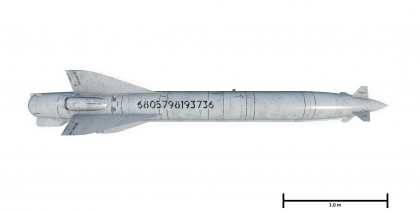Difference between revisions of "Kh-23M"
m (Removed extra bullet points in the pros and cons section.) |
Colok76286 (talk | contribs) |
||
| Line 57: | Line 57: | ||
* Compared to it's NATO contemporary, the AGM-12B, it has slightly higher TNT equivalent in the warhead (96kg vs 58.05kg), and it has a faster speed (686m/s vs 455m/s) along with a slightly longer guidance range (10km vs 8km) and very slightly more penetration (78mm vs 73mm). | * Compared to it's NATO contemporary, the AGM-12B, it has slightly higher TNT equivalent in the warhead (96kg vs 58.05kg), and it has a faster speed (686m/s vs 455m/s) along with a slightly longer guidance range (10km vs 8km) and very slightly more penetration (78mm vs 73mm). | ||
| + | * | ||
'''Cons:''' | '''Cons:''' | ||
| Line 64: | Line 65: | ||
* The mass is slightly higher than the AGM-12B at 289kg vs 259kg. | * The mass is slightly higher than the AGM-12B at 289kg vs 259kg. | ||
* Requires a direct hit to take out any relatively heavily armored target. | * Requires a direct hit to take out any relatively heavily armored target. | ||
| + | |||
| + | * | ||
== History == | == History == | ||
Revision as of 18:51, 4 September 2022
Contents
Description
The Kh-23M is a Soviet manually-guided air-to-ground missile. It was introduced in Update "New Power".
Vehicles equipped with this weapon
| Vehicles equipped with this weapon | |
|---|---|
| Jet fighters | MiG-23M · ◊MiG-23MF · ◊MiG-23MLA · MiG-23MLD |
| MiG-27K · MiG-27M | |
| Strike aircraft | Su-17M2 · Su-17M4 |
| Su-22M3 · ◊Su-22UM3K | |
| Yak-38 · Yak-38M | |
General info
The Kh-23M is a modernized variant of the Kh-23 air-to-surface missile, designed to be used against small ground and naval targets. Controlled by command radio guidance, a tracer element is used to determine the position of the missile as it is guided to the target. The missile weighs 289 kg, but the warhead consists of a 75 kg shaped charge/fragmentation warhead (with TNT equivalence of 96 kg), capable of penetrating 78 mm RHA.
| Missile characteristics | |
|---|---|
| Mass | 289 kg |
| Guidance | Manual (MCLOS) |
| Maximum speed | 2 M |
| Missile guidance time | 25 secs |
| Firing range | 10 km |
| Explosive mass | 96 kg TNTeq |
| Armour penetration | 78 mm |
The Kh-23M is a versatile missile. It is comparable to the AGM-12 Bullpup and AGM-62 Walleye. While it does not pack a punch bigger than the AGM-12C Bullpup, it is the counterpart of the AGM-12B with a similar explosive mass and penetration.
Comparison with analogues
- AGM-12B - It has little to no differences but missile speed (445 m/s vs 686 m/s) and guidance time (30 seconds vs 25 seconds)
- AGM-12C - The same differences as AGM-12B but with a significantly increased explosive warhead (96 kg vs 136 kg)
Usage in battles
The Kh-23M is most effective at destroying stationary targets or slow moving ones. The explosive mass is something that lacks and should be compensated by precise hits. It has a maximum range of 10 kilometres (5.4 nmi). It can be manually controlled like the AGM-12 Bullpups and AS-30 Nords. There are no significant differences in flight performance aside from the missile speed.
While the Kh-23M has very low penetration capabilities (78 mm at any range and angle), any direct hit will ensure target destruction. The warhead is fairly small and mediocre compared to other missiles, even rockets. However, it is enough to take a heavily armoured target if a direct hit is achieved.
Pros and cons
Pros:
- Compared to it's NATO contemporary, the AGM-12B, it has slightly higher TNT equivalent in the warhead (96kg vs 58.05kg), and it has a faster speed (686m/s vs 455m/s) along with a slightly longer guidance range (10km vs 8km) and very slightly more penetration (78mm vs 73mm).
Cons:
- Requires a pylon to be taken up by the [[Delta-NG]] targeting pod unlike most equivalent MCLOS AGMs such as the Bullpup and Nords.
- Relatively low explosive mass (only 96kg TNTeq) in the warhead, as well as low penetration (78mm), thus requiring a direct hit to be effective against heavily armored targets.
- The mass is slightly higher than the AGM-12B at 289kg vs 259kg.
- Requires a direct hit to take out any relatively heavily armored target.
History
The story of the Kh-23M starts with the K-66 missile. The K-66 used a K-8 missile airframe with the beam riding guidance systems of the K-5 AAM. The K-66 was a stop gap measure as it required the pilot to maintain a dive to guide the missile. It entered service in 1968. Meanwhile, development on the Kh-23 continued. Improvements to the motor were made, but the largest difference was the switch from the beam guidance system to radio guidance, similar to that of the American Bullpup system. The new guidance system allowed the missile to be fired from level flight. The Kh-23 entered service in 1973, a further advanced missile, the laser-guided Kh-25, was developed from the Kh-23 with improvements being back-ported to create the Kh-23M which entered service in 1974. A continuous problem with the Kh-23M was the pilot's need to pay continual attention to guide the missile, meaning the pilot had to avoid using the missile in a hostile airspace and rather focus on defensive manoeuvres.
Media
Excellent additions to the article would be video guides, screenshots from the game, and photos.
See also
Links to the articles on the War Thunder Wiki that you think will be useful for the reader, for example:
- reference to the article about the variant of the weapon;
- references to approximate analogues by other nations and research trees.
External links




